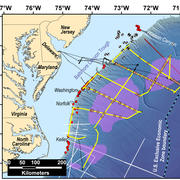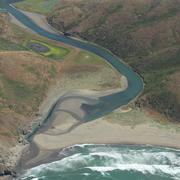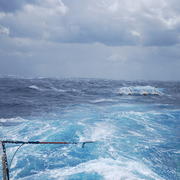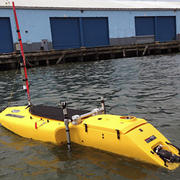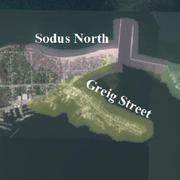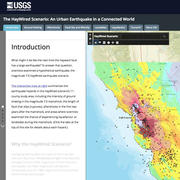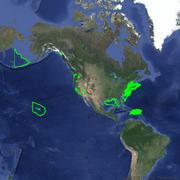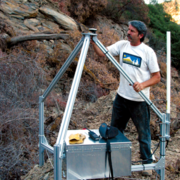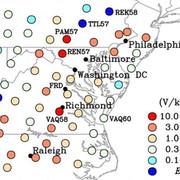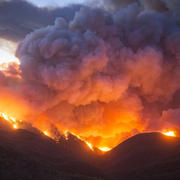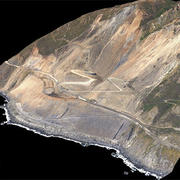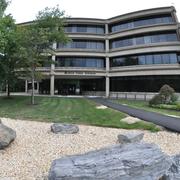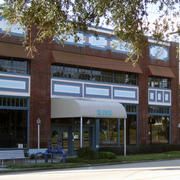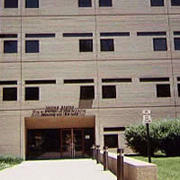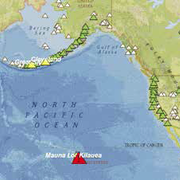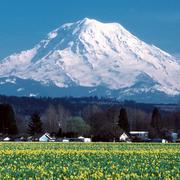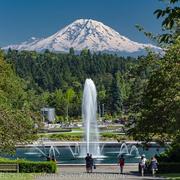Due to a lapse in appropriations, the majority of USGS websites may not be up to date and may not reflect current conditions. Websites displaying real-time data, such as Earthquake and Water and information needed for public health and safety will be updated with limited support. Additionally, USGS will not be able to respond to inquiries until appropriations are enacted. For more information, please see www.doi.gov/shutdown
Mission Areas
Natural Hazards
Mission Areas L2 Landing Page Tabs
Costs and consequences of natural hazards can be enormous; each year more people and infrastructure are at risk. We develop and apply hazards science to help protect U.S. safety, security, and economic well being. These scientific observations, analyses, and research are crucial for the Nation to become more resilient to natural hazards.
Read Our Science StrategyCross-Shore and Inlets (CSI) Processes
Exchange of flows, sediment, and biological particles between the inner shelf and back-barrier estuaries are significant for determination of extreme water levels, maintenance and formation of inlets, barrier-island evolution, and pollutant and larval transport. These connections are controlled by cross-shore processes including wave-driven inner-shelf and near-shore processes, dune...
The Mid-Atlantic Resource Imaging Experiment (MATRIX)
In late August 2018, scientists and technical staff from the USGS Coastal/Marine Hazards and Resources Program completed the acquisition of over 2000 km of multichannel seismic (MCS) data as part of the Mid-Atlantic Resource Imaging Experiment (MATRIX) conducted aboard the...
Woods Hole Coastal and Marine Science Center Featured Photos
This page highlights images from the field, where we work, and USGS at work.
Sediment Transport in Coastal Environments
Our research goals are to provide the scientific information, knowledge, and tools required to ensure that decisions about land and resource use, management practices, and future development in the coastal zone and adjacent watersheds can be evaluated with a complete understanding of the probable effects on coastal ecosystems and communities, and a full assessment of their vulnerability to...
Coral Reef Project
Explore the fascinating undersea world of coral reefs. Learn how we map, monitor, and model coral reefs so we can better understand, protect, and preserve our Nation's reefs.
USGS Law of the Sea
The USGS Law of the Sea project helps identify the submerged extent of the U.S. land territory beyond 200 nautical miles. This land area, called the extended continental shelf (ECS), is an important maritime zone with resources and marine habitats. Its size may exceed one million square kilometers, encompassing areas in the Arctic, Atlantic, Bering Sea, Gulf of Mexico, and Pacific west coast....
Significant Earthquakes on a major fault system in Hispaniola, Puerto Rico, the Virgin Islands, and the Lesser Antilles, 1500–2010: Implications for Seismic Hazard
Earthquakes have been documented in the northeastern Caribbean since the arrival of Columbus to the Americas; written accounts of these felt earthquakes exist in various parts of the world. To better understand the earthquake cycle in the Caribbean, the records of earthquakes in earlier catalogs and historical documents from various archives, which are now available online, were critically...
Analytical Facilities
The Core Laboratories Project is a research support service of the WHCMSC which provides analytical and technical infrastructure, and supports of a range of projects associated with Coastal Biogeochemical Processes, Coastal Groundwater, Climate-Hydrates, and Sedimentology.
The Core Laboratories Project is a research support service of the WHCMSC which provides analytical and technical...
Coastal Model Applications and Field Measurements- Tools and Standards for Ocean Modeling
Ocean models provide critical information for coastal and marine spatial planning, emergency responders and for understanding implications of climate change and human activities. Models are run by numerous academic institutions and government agencies, typically with different access protocols that stifle use, comparison with data, and innovation.
Coastal Model Applications and Field Measurements- Field Measurements and Model Applications
Several components of this project are applications to evaluate the model against critical field measurements or to test new model components. Data from field measurements is described in our publications and available in our databases.
Coastal Model Applications and Field Measurements- Advances in Instrumentation
Ongoing acquisition of new instruments and development of analytical methods provides us with the means to make better observations of coastal ocean processes. The measurements provide us with insight and data for critical evaluation of model performance. Advances in a range of measurement capabilities, including bottom stress, sediment erodibility, water properties and nutrient concentrations...
Coastal Model Applications and Field Measurements- Ocean Model Contributions
The U.S. Geological Survey (USGS) and Woods Hole Oceanographic Institution (WHOI) led a project funded by the National Oceanographic Partnership Program (NOPP) with support from the Office of Naval Research (ONR) and the National Science Foundation (NSF), to develop a community sediment-transport modeling system (CSTMS).
Post-Fire Debris Flows
Estimates of the probability and volume of debris flows that may be produced by a storm in a recently burned area, using a model with characteristics related to basin shape, burn severity, soil properties, and rainfall.
Aerial imagery and photogrammetric products from unmanned aerial systems (UAS) flights over the Lake Ontario shoreline at Sodus Bay, New York, July 12 to 14, 2017
This data release includes images tagged with locations determined from the UAS GPS; tables with updated estimates of camera positions and attitudes based on the photogrammetric reconstruction; tables listing locations of the base stations, ground control points, and transect points; geolocated, RGB-colored point clouds; orthomosaic images; and digital elevation models for each of the regions...
Our Coast Our Future
Our Coast, Our Future (OCOF) is a collaborative, user-driven project focused on providing California coastal resource managers and planners locally relevant, online maps and tools to help understand, visualize, and anticipate vulnerabilities to sea level rise and storms.
Sea-Floor Sediment Samples, Seabed Imagery, and CTD Instrument Data Collected on Stellwagen Bank in August 2017, U.S. Geological Survey Field Activity 2017-043-FA
The data collected in this study will aid research on the ecology of fish and invertebrate species that inhabit the region. On August 22 and 23, 2017, the U.S. Geological Survey, in collaboration with the Stellwagen Bank National Marine Sanctuary, conducted a research cruise aboard the Sanctuary’s Research Vessel Auk, visiting 39 locations within the sanctuary.
Seismic reflection and sample data collected offshore of Fire Island, New York in 2014, U.S. Geological Field Activity 2014-009-FA
The U.S. Geological Survey (USGS) conducted a geophysical and sampling survey in October 2014 that focused on a series of shoreface-attached ridges offshore of western Fire Island, NY. Seismic-reflection data, surficial grab samples and bottom photographs and video were collected along the lower shoreface and inner continental shelf to assess the impact of Hurricane Sandy on the coastal region...
HayWired aftershock (M> 5) ShakeMaps
The maps in this archive display estimated intensities and ground motions for the earthquake scenarios - events on faults that have ruptured in the past or have a likelihood of rupturing in the future. These maps are typically used for emergency response exercises and planning as well as for understanding the potential consequences of future large earthquakes.
The HayWired Scenario: An Urban Earthquake in a Connected World - A Geonarrative
What might it be like the next time the Hayward Fault has a large earthquake? A geonarrative and related imagery examines a hypothetical earthquake, the magnitude 7.0 HayWired earthquake scenario.”
What to Expect in a Big Urban Earthquake - A Geonarrative
How do we get ready for big earthquakes in populated areas? An important first step is to learn what a big earthquake could be like. These pages summarize the main patterns — the earthquake effects that show up again and again. Here, urban is shorthand for “cities, towns, and suburbs”.
Marsh shorelines of the Massachusetts coast from 2013-14 topographic lidar data
The Massachusetts Office of Coastal Zone Management (CZM) launched the Shoreline Change Project in 1989 to identify erosion-prone areas of the Massachusetts coast. This update included a marsh shoreline, which was defined to be the tonal difference between low- and high-marsh seen in ortho-photos. Further cooperation between CZM and the U.S. Geological Survey (USGS) has resulted in another...
Collection, analysis, and age-dating of sediment cores from salt marshes on the south shore of Cape Cod, Massachusetts, from 2013 through 2014
Elevation of the marsh surface was measured with RTK-GPS to evaluate where the marsh falls within the current tidal frame. The historic marsh surface elevation was then reconstructed using the calculated age of each depth interval and its elevation, assuming that elevations within this shallow zone (less than 30 cm) have been preserved for the past century.
U.S. Geological Survey Oceanographic Time-Series Data Collection
Oceanographic time-series measurements made by the U.S. Geological Survey between 1975 and the present as part of research programs. The data were collected to address specific research questions and were primarily collected over durations less than a year, using stationary platforms, with sensors near the sea floor. These data have been used to study of ocean dynamics and to validate ocean...
Coastal and Marine Geology Program Internet Map Server and GIS Data
The USGS Coastal and Marine Geology Program (CMGP) Internet Map Server is an interactive mapping service which allows the user to explore and download GIS data sets published by CMGP.
Additional period and site class maps for the 2014 National Seismic Hazard Model for the conterminous United States
The 2014 update of the U.S. Geological Survey (USGS) National Seismic Hazard Model (NSHM) for the conterminous United States (2014 NSHM; Petersen and others, 2014, 2015) included probabilistic ground motion maps for 2 percent and 10 percent probabilities of exceedance in 50 years, derived from seismic hazard curves for peak ground...
Shumway, Allison; Petersen, Mark D.; Powers, Peter M.; Rezaeian, SanazKG²B, a collaborative benchmarking exercise for estimating the permeability of the Grimsel granodiorite - Part 1: measurements, pressure dependence and pore-fluid effects
Measuring the permeability of tight rocks remains a challenging task. In addition to the traditional sources of errors that affect more permeable formations (e.g. sample selection, non-representative specimens, disturbance introduced during sample acquisition and preparation), tight rocks can be particularly prone to solid–fluid interactions and...
David, Christian; Wasserman, J.; Amann, F.; Lockner, David A.; Rutter, E.H.; Vanorio, T; Amann Hildenbrand, A.; Billiotte, J.; Reuschle, T.; Lasseux, D.; Fortin, J.; Lenormand, R.; Selvadurai, A.P.S.; Meredith, P.G.; Browning, J.; Mitchell, T.M.; Loggia, D.; Nono, F.; Sarout, J.; Esteban, L.; Davy, C.; Louis, L.; Boitnott, G.; Madonna, C.; Jahns, E.; Fleury. M.; Berthe, G.; Delage, P.; Braun, P.; Grégoire, D.; Perrier, L.; Polito, P.; Jannot, Y.; Sommier, A.; Krooss, B.; Fink, R.; Hu, Q.; Klaver, J.; Clark, A.Induced earthquake families reveal distinctive evolutionary patterns near disposal wells
The timing of events in seismic sequences can provide insights into the physical processes controlling fault slip. In southern Kansas, the rate of earthquakes rose rapidly starting in 2013 following expansion of energy production into the area, demanding the disposal of large volumes of wastewater into deep wells. Seismicity catalogs that are...
Cochran, Elizabeth S.; Ross, Zachary E.; Harrington, Rebecca M.; Dougherty, Sara L.; Rubinstein, Justin L.Research to improve ShakeAlert earthquake early warning products and their utility
Earthquake early warning (EEW) is the rapid detection of an earthquake and issuance of an alert or notification to people and vulnerable systems likely to experience potentially damaging ground shaking. The level of ground shaking that is considered damaging is defined by the specific application; for example, manufacturing equipment may...
Cochran, Elizabeth S.; Aagaard, Brad T.; Allen, Richard M.; Andrews, Jennifer; Baltay, Annemarie S.; Barbour, Andrew J.; Bodin, Paul; Brooks, Benjamin A.; Chung, Angela; Crowell, Brendan W.; Given, Douglas D.; Hanks, Thomas C.; Hartog, J. Renate; Hauksson, Egill; Heaton, Thomas H.; McBride, Sara; Meier, Men-Andrin; Melgar, Diego; Minson, Sarah E.; Murray, Jessica R.; Strauss, Jennifer A.; Toomey, DouglasBack to full interseismic plate locking decades after the giant 1960 Chile earthquake
Great megathrust earthquakes arise from the sudden release of energy accumulated during centuries of interseismic plate convergence. The moment deficit (energy available for future earthquakes) is commonly inferred by integrating the rate of interseismic plate locking over the time since the previous great earthquake. But accurate integration...
Melnick, Daniel; Li, Shaoyang; Moreno, Marcos; Cisternas, Macro; Jara-Muñoz, Julius; Wesson, Robert L.; Nelson, Alan R.; Báez, Juan Carlos; Deng, ZhiguoThe Hayward Fault—Is it due for a repeat of the powerful 1868 earthquake?
On October 21, 1868, a magnitude 6.8 earthquake struck the San Francisco Bay area. Although the region was sparsely populated, the quake on the Hayward Fault was one of the most destructive in California’s history. U.S. Geological Survey (USGS) studies show that similar Hayward Fault quakes have repeatedly jolted the region in the past and that...
Brocher, Thomas M.; Boatwright, Jack; Lienkaemper, James J.; Prentice, Carol S.; Schwartz, David P.; Bundock, HowardIntensities, aftershock sequences, and the location of the 1936 Milton‐Freewater earthquake near the Oregon–Washington border, U.S.A.
The epicenter of the 16 July 1936 M">MM 6 Milton‐Freewater earthquake, also known as the State Line earthquake and the largest historical earthquake in northeastern Oregon or southeastern Washington, is uncertain. Various studies place the epicenter of the earthquake, which was widely felt in eastern Washington, northeastern Oregon,...
Brocher, Thomas M.; Sherrod, BrianA physics-based earthquake simulator replicates seismic hazard statistics across California
Seismic hazard models are important for society, feeding into building codes and hazard mitigation efforts. These models, however, rest on many uncertain assumptions and are difficult to test observationally because of the long recurrence times of large earthquakes. Physics-based earthquake simulators offer a potentially helpful tool, but they...
Shaw, Bruce E.; Milner, Kevin R.; Field, Edward H.; Richards-Dinger, Keith B.; Gilchrist, Jacquelyn J.; Dieterich, James H.; Jordan, Thomas H.Bedrock mapping and seismic hazard assessment at Gold Basin landslide, Washington
The Gold Basin landslide is located along the South Fork Stillaguamish River, within the Mount Baker-Snoqualmie National Forest in western Washington State. Recent concerns related to slope stability after the 2014 State Route 530 Landslide near Oso, Washington, forced the closure of the U.S. Forest Service Gold Basin Campground in May of 2014. In...
Staisch, Lydia M.Modeling the Holocene slip history of the Wasatch fault (Utah): Coseismic and postseismic Coulomb stress changes and implications for paleoseismicity and seismic hazard
The Wasatch fault zone defines the eastern boundary of the actively extending Basin and Range Province (Utah, western United States) and poses a significant seismic hazard to the metropolitan areas along the Wasatch Range. A wealth of paleoseismological data documents ∼24 surface-rupturing Mw ≥ 7 earthquakes along the Wasatch fault during the past...
Bagge, Meike; Hampel andrea; Gold, Ryan D.Slab2, a comprehensive subduction zone geometry model
Subduction zones are home to the most seismically active faults on the planet. The shallow megathrust interfaces of subduction zones host our largest earthquakes and are likely the only faults capable of magnitude 9+ ruptures. Despite these facts, our knowledge of subduction zone geometry—which likely plays a key role in determining the spatial...
Hayes, Gavin; Moore, Ginevra; Portner, Daniel E.; Hearne, Mike; Flamme, Hanna E.; Furtney, Maria; Smoczyk, Gregory M.The case for mean rupture distance in ground‐motion estimation
This article advocates for the use of mean rupture distances that we contend are more physically representative of the distance to an earthquake and are simpler than minimum distances. Many current ground‐motion models (GMMs) rely on numerous modifications of minimum rupture distances to accurately model near‐source ground motions. These...
Thompson, Eric M.; Baltay, Annemarie S.Aerial image of Quissett Campus, Woods Hole, MA
Screenshot of a point cloud containing more than 50 million points from a photogrammetry project of the Quissett Campus. This point cloud was created from 633 photographs taken from a unmanned aircraft system (UAS) in Woods Hole, Massachusetts in July 2018
Northwest ShakeAlert Sensor Station
Maintenance of a high-quality ShakeAlert sensors, power and telemetry stations.
Collage of USGS staff in the field
Upper Left: Dann Blackwood operating the SEABOSS winch during a sampling cruise; Lower left: Bill Schwab, Laura Brothers and Emile Bergeron on the deck of a research vessel; Center Left: Tom O'Brien carrying equipment during a research cruise; Center: USGS staff deploying a seismic system from a research vessel; left: Chuck Worley ready to deploy a multibeam echosounder
...Outstanding in the field
USGS Research Geologist Dr. Erika Lentz is conducting real-time kinematic GPS surveys on barrier island dunes, part of her research looking at how coastal landscapes respond to sea-level rise.
B-Roll California ShakeAlert Sensor
Maintenance of high quality ShakeAlert sensor, power and telemetry station.
Potential coastal change impacts for Hurricane Florence - 9/11/2018
Screen shot of the Coastal Change Hazards Portal showing potential coastal change impacts during a direct landfall of Hurricane Florence based on NHC Advisory 48, 500 AM AST TUE SEP 11 2018.
Hurricane Florence will erode or overwash beaches
The USGS Coastal Change Hazards Storm Team has forecast coast-wide levels of beach erosion, inundation and overwash due to Hurricane Florence's expected path and landgfall.
Sea water levels to go up, stay up as Florence affects coast
The Coastal Change Hazards Storm Team has forecast changing water levels at specific locations over time.
USGS Scientists Get Ready for Hurricanes
A USGS hydrologic scientist installs a storm-tide sensor near the North Carolina coast as Hurricane Florence approaches.
Peace at dusk
USGS oceanographer Shawn Harrison stands on the coastal bluff of Barter Island, Alaska at sunset. Shawn and his fellow researchers are studying how the highly erosive bluff changes under the varied conditions experienced by this stretch of coastline. The knowledge gained will be used to improve computer-derived simulations of shoreline change, that in turn communities can
...PubTalk 8/2018 — What on Earth is going on at Kilauea Volcano?
Title: What on Earth is going on at Kilauea Volcano?
- First significant summit explosions in nearly a century
- Largest summit collapse volume since at least 1800
- Voluminous fissure eruptions feeding channelized lava flow
- Unparalleled new opportunities for understanding the volcanic system
USGS announces awards for 2018 earthquake monitoring and research in the United States
The U.S Geological Survey announces that the agency has awarded more than $20 million in 2018 for earthquake monitoring and applied research.
Woods Hole Coastal and Marine Science Center staff teach the teachers
Meagan Gonneea, Neil Ganju, and Matt Arsenaualt, Woods Hole Costal and Marine Science Center staff offered presentations and handouts on Natural Hazards: Coastal Hazards in Wetlands and Estuaries to participants at the Smithsonian Science Education Academies for Teachers (SSEATs. )
Down to Earth With: The USGS Landslide Response Team
Interview by EARTH magazine of members of the USGS Landslide Response Team. Read Article.
Mapping Extreme-Value Geoelectric Fields
To help mitigate magnetic storm interference on electric power grid operations, extreme-value geoelectric fields have been mapped across the mid-Atlantic United States. (EOS article) Read Article.
New instruments installed to measure Arctic coastal erosion
In July 2018, three USGS Pacific Coastal and Marine Science Center researchers installed instruments and hosted a community outreach event.
Scientists complete mission to map fast-moving fault off Alaska: Data will help coastal communities prepare for risks from earthquakes and tsunamis
Researchers from NOAA, U.S. Geological Survey and their partners have completed the first high-resolution, comprehensive mapping of one of the fastest moving underwater tectonic faults in the world, located in southeastern Alaska. This information will help communities in coastal Alaska and Canada better understand and prepare for the risks from earthquakes and tsunamis that can occur when faults suddenly move.
Better Performance and New Features on Earthquake Website
Better performance and new features: landslides and liquefaction estimates, population map layer, Spanish Did You Feel It?, and aftershock forecasts.
Follow National Wildfire Information in the Palm of Your Hand: GeoMAC Goes Mobile
The public can now access information about active wildfires across the country using a smartphone.
MEDIA ADVISORY: Join GeoGirls at Mount St. Helens August 1
Twenty-five middle-school girls from Washington and Oregon are participating in the fourth annual “GeoGirls” outdoor volcano science program at Mount St. Helens, jointly organized by the U.S. Geological Survey and the Mount St. Helens Institute.
Researchers Develop Model for Predicting Landslides Caused by Earthquakes
A model developed by researchers at Indiana University and the USGS can help experts address such risks by estimating the likelihood of landslides that will be caused by earthquakes anywhere in the world within minutes. Read story.
Time-lapse view of California Highway 1 reconstruction after 2017 landslide
USGS scientists produced an animated GIF in coordination with the California Department of Transportation (Caltrans) re-opening of State Highway 1 through Big Sur on July 18, 2018.
A New Map of Rodgers Creek Fault in Sonoma County, California
A new more detailed and higher resolution map of the Rodgers Creek Fault in Sonoma County, California, has been produced using aerial photography and hillshade imagery derived from LiDAR data.



